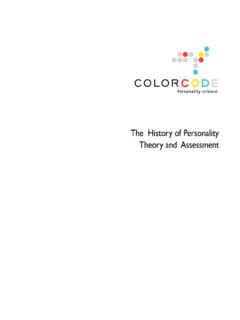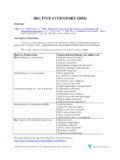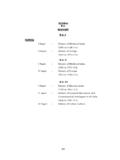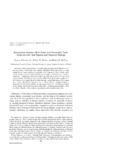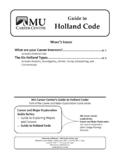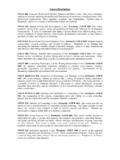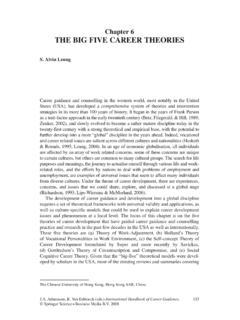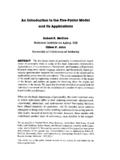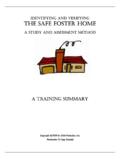Transcription of Oliver P. John Sanjay Srivastava - Moityca
1 The Big-Five Trait Taxonomy: History, Measurement, and Theoretical Perspectives Oliver P. John and Sanjay Srivastava University of California at Berkeley Running head: Big Five Trait Taxonomy Final draft: March 5, 1999 Author's Address: Oliver P. John Department of Psychology University of California, MC 1650 Berkeley, CA 94720-1650 W: (510) 642-2178; H: 540-7159; Fax: 643-9334 Email: To appear in L. Pervin and John (Eds.), Handbook of personality : Theory and research (2nd ed.). New York: Guilford (in press). 2 Taxonomy is always a contentious issue because the world does not come to us in neat little packages (S. J. Gould, 1981, p. 158). personality has been conceptualized from a variety of theoretical perspectives, and at various levels of abstraction or breadth (John, Hampson, & Goldberg, 1991; McAdams, 1995).
2 Each of these levels has made unique contributions to our understanding of individual differences in behavior and experience. However, the number of personality traits, and scales designed to measure them, escalated without an end in sight (Goldberg, 1971). Researchers, as well as practitioners in the field of personality assessment, were faced with a bewildering array of personality scales from which to choose, with little guidance and no overall rationale at hand. What made matters worse was that scales with the same name often measure concepts that are not the same, and scales with different names often measure concepts that are quite similar. Although diversity and scientific pluralism are useful, the systematic accumulation of findings and the communication among researchers became difficult amidst the Babel of concepts and scales.
3 Many personality researchers had hoped that they might devise the structure that would transform the Babel into a community speaking a common language. However, such an integration was not to be achieved by any one researcher or by any one theoretical perspective. As Allport once put it, each assessor has his own pet units and uses a pet battery of diagnostic devices (1958, p. 258). What personality psychology needed was a descriptive model, or taxonomy, of its subject matter. One of the central goals of scientific taxonomies is the definition of overarching domains within which large numbers of specific instances can be understood in a simplified way. Thus, in personality psychology, a taxonomy would permit researchers to study specified domains of personality characteristics, rather than examining separately the thousands of particular attributes that make human beings individual and unique.
4 Moreover, a generally accepted taxonomy would greatly facilitate the accumulation and communication of empirical findings by offering a standard vocabulary, or nomenclature. After decades of research, the field is approaching consensus on a general taxonomy of personality traits, the Big Five personality dimensions. These dimensions do not represent a particular theoretical perspective but were derived from analyses of the natural-language terms people use to describe themselves 3 and others. Rather than replacing all previous systems, the Big Five taxonomy serves an integrative function because it can represent the various and diverse systems of personality description in a common framework.
5 It thus provides a starting place for vigorous research and theorizing that can eventually lead to an explication and revision of the descriptive taxonomy in causal and dynamic terms. In this chapter, we first review the history of the Big Five, including the discovery of the five dimensions, research replicating and extending the model, its convergence with research in the questionnaire tradition, and the development of several instruments to measure the Big Five. Then, we compare three of the most frequently used instruments and report data regarding their reliability and convergent validity. Finally, we address a number of critical issues, including how the Big Five taxonomy is structured hierarchically, how the five dimensions develop, whether they predict important life outcomes, how they combine into personality types, and whether they are descriptive or explanatory concepts.
6 The Lexical Approach and Discovery of the Big Five One starting place for a shared taxonomy is the natural language of personality description. Beginning with Klages (1926), Baumgarten (1933), and Allport and Odbert (1936), various psychologists have turned to the natural language as a source of attributes for a scientific taxonomy. This work, beginning with the extraction of all personality -relevant terms from the dictionary, has generally been guided by the lexical approach (see John et al., 1988; Saucier & Goldberg, 1996a). The lexical hypothesis posits that most of the socially relevant and salient personality characteristics have become encoded in the natural language ( , Allport, 1937).
7 Thus, the personality vocabulary contained in the dictionaries of a natural language provides an extensive, yet finite, set of attributes that the people speaking that language have found important and useful in their daily interactions (Goldberg, 1981). Allport and Odbert s Psycholexical Study: Traits, States, Activities, and Evaluations Following Baumgarten's (1933) work in German, Allport and Odbert (1936) conducted a seminal lexical study of the personality -relevant terms in an unabridged English dictionary. They included all the terms that could be used to distinguish the behavior of one human being from that of another (Allport & Odbert, 1936, p. 24). Their complete list amounted to almost 18,000 terms.
8 At the time, the staggering size of this list seemed like a semantic nightmare (Allport, 1937, pp. 353-354). Allport and Odbert thought that 4 organizing these thousands of personality attributes into a satisfactory taxonomy would keep a psychologist at work for a life time (1936, p. vi). Indeed, this task has occupied personality psychologists for more than 60 years. (For detailed reviews of the history of the lexical approach see John et al., 1988; John, 1990). Allport and Odbert (1936) tried to bring some order to the semantic nightmare they had created. What kinds of person descriptors are included in the dictionary? Allport and Odbert identified four major categories. The first category included personality traits ( , sociable, aggressive, and fearful), which they defined as generalized and personalized determining tendencies--consistent and stable modes of an individual s adjustment to his environment (p.)
9 26). The second category included temporary states, moods, and activities, such as afraid, rejoicing, and elated. The third category consisted of highly evaluative judgments of personal conduct and reputation, such as excellent, worthy, average, and irritating. Although these terms presuppose some traits within the individual, they do not indicate the specific attributes that gave rise to the individual s evaluation by others or by society in general. The last category included physical characteristics, capacities and talents, terms of doubtful relevance to personality , and terms that could not be assigned to any of the other three categories. Norman (1967) subsequently elaborated Allport and Odbert s initial classification and divided the domain into seven content categories: stable biophysical traits; temporary states; activities; social roles; social effects; evaluative terms; anatomical and physical terms; as well as ambiguous and obscure terms not considered useful for personality descriptive purposes.
10 These categories illustrate that the personality lexicon in the natural language includes a wealth of concepts. Individuals can be described by their enduring traits ( , irrascible), by the internal states they typically experience (furious), by the physical states they endure (trembling), by the activities they engage in (screaming), by the effects they have on others (frightening), by the roles they play (murderer), and by social evaluations of their conduct (unacceptable, bad). Moreover, individuals differ in their anatomical and morphological characteristics (short) and in the personal and societal evaluations attached to these appearance characteristics (cute). Both Allport and Odbert (1936) and Norman (1967) classified the terms culled from the dictionary into mutually exclusive categories.
